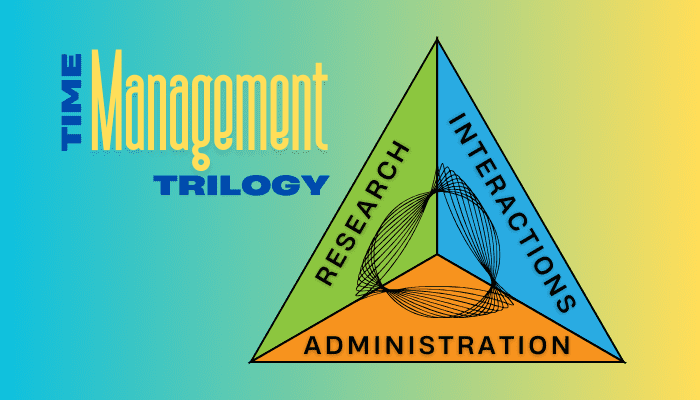Are you new to a business development role? Want to know the key business development strategies and best practices to implement?
Maybe you’ve been in a role in business development for a while, but you’re trying to figure out how to speed up the acquisition of new accounts.
Whether you’re new to the role or you’ve been in the role a while, there are some business development strategies and best practices that you should be using, which will help you speed things up and ultimately be more successful in business development.
Let’s get into it.
5 Key Business Development Strategies to Drive Growth
(0:49):
When it comes to business development, you can spend a lot of time doing research and a lot of time traveling and meeting with new prospects, learning about new companies. It all takes a lot of time. So, what you want to consider is how to best manage your time.
1. Take Charge of the Time Management Trilogy

To be more effective, you’ll want to use what I refer to as the “Time Management Trilogy“. Think about a triangle with three sides:
- On one side you’ve got research.
- On the other side, you’ve got interactions, and
- along the bottom you’ve got administration.
If you think about your role in business development, it gets packaged into these three areas.
You’re spending time researching that might be attending an event, might be doing some research online, might be calling some of your colleagues to learn more about potential companies that you can pursue.
Then you’ve got the interaction. This is traveling to meet people, setting up meetings, attending meetings, and participating in meetings. Your travel might even be globally, so there can be a lot of time spent here as well.
Then you’ve got administration, which is all of the other stuff.
Your goal with the time management business development strategy is to increase the time spent at the top of the triangle and reduce the time along the bottom.
- Take a look at your activities related to research and your activities related to interacting, traveling, having meetings, connecting with, and speaking to potential companies and even partners. Ask yourself, how do I increase the time spent in these areas?
- You can even look at your calendar and ask, in a week, how much time do I spend in these two areas?
What I find is that once you’ve been into business development for a while, you fall into the trap of administration. That is all the other stuff, updating notes, updating CRM, just doing administrative stuff that really doesn’t help you sell. That’s where a lot of your time can get spent, meaning you don’t have as much time available to generate those new business opportunities.
If you are new or even if you’ve been around for a while, just make sure you’re very cognizant of the fact that we want to spend as much time as possible in the top half or the top portion of that triangle and minimize and manage the time spent along the bottom.
2. Master Managing Multiple Relationships

(2:58):
The next thing for you to consider relative to best practices in business development is you’ve got to be a master at managing multiple relationships.
You see, the goal is not to identify one company and then invest a lot of time and money in going after that company. It’s to identify a number of companies because you’ll learn at different stages along the way of those that might be a really good fit versus those that aren’t a great fit.
You have to be able to manage multiple relationships at once, even more so within each company. There are multiple people that you should be pursuing.
Don’t just identify one person, your ideal buyer. Think about all the people that can influence that buyer, and you want to build multiple relationships.
The best business development people master relationship building.
Now, the easiest way to do that is some sort of CRM system. But, you can use a spreadsheet if you need to. For each company, identify all of the people every time you have an interaction. Just put a date somewhere that captures when you met, what you talked about, and what the next step is so that you can stay on top of these relationships and keep moving them forward.
You see, the faster you can connect with people and move these relationships forward, the faster you can convert this from a potential customer or client to an actual customer or client.
You’ve got to get good not only at managing your time, but at mastering the art of managing multiple relationships and accelerating those relationships, but not doing so to the extent that you hurt trust.
So get yourself a CRM or a spreadsheet and start to track all of the people and all the companies you’re pursuing so you know what the next step is in every single relationship.
3. A Key Business Development Strategy is Knowing When to Stop

(4:45):
When it comes to business development, you also have to be good at knowing when to stop.
You see, sometimes you may put a lot of effort into a company and then realize along the way that it’s probably not a good fit. Now, what do you do when that happens?
Well, I wouldn’t make that judgment myself. If I’ve put in a lot of time and effort, I might run that by my boss, my peers, the owner of the company, or whoever you report to. Then say, “Here’s a company I’ve been pursuing, but I’m not thinking they’re the best fit.”
Whatever the case is. However you determine best to do that, whether you do it on your own or you get some feedback, make sure you do it quickly.
What I mean by that is when you get a sense that a company’s not a good fit, don’t keep going. Don’t say, “Well, jeepers have put so much time into this, I should keep moving forward.” No, you shouldn’t, because it may be even more wasted time if you do pursue it.
So when you get the sense that a company that you’ve been pursuing or an individual within a company is not a good fit, stop. Reassess the relationship. Ask yourself the serious question, should I keep moving forward?
Maybe it’s not a matter of dropping that person, that company, or that relationship, but it’s a matter of slowing down and investing your time in other relationships that you deem to be more fruitful. Knowing that there’s a better or bigger opportunity.
You see, we’ve always got to be judging the best opportunities for us to pursue, and we want to reassess our time accordingly.
But if you get that gut instinct or that sense that the relationship’s not good, stop. Don’t keep going. Reassess, and reevaluate how you can best move forward.
4. Clarifying Ideal Customer Criteria

(6:13):
Another key business development strategy is to be clear on your prospects and those ideal companies you’re trying to move forward with and build relationships with.
Be clear not only for yourself but for others within your company to define the criteria of your best or ideal customers.
Let me give you an example of this. Let’s say you’re selling commercial insurance and you prefer to sell to businesses versus an individual. Obviously in the commercial side of things, but you’re trying to sell the businesses that are of a certain size, a certain revenue size, a certain number of employees.
You have defined those as being ideal for you. You need to be able to map this out, even if it’s a checklist.
Because when you’re trying to explain to others within your company why you might be pursuing a certain company, they don’t get it. They can’t make the connection. Maybe they heard something bad about the company and they’re like, oh, why would you bother? Why would you waste your time here? Or they just don’t understand why you believe that company is a good fit.
So make sure you get clear on the criteria for you that identify what is an ideal company or an ideal prospect for you to pursue. Document that and share that with others. Because if you share with others and they run across companies that might be a good fit, they’re going to refer them over.
They’re going to say, “Hey, Sean, you shared with me the criteria of the ideal companies you’d like to pursue. There’s a company I’ve been talking to or my niece or nephew or cousin or uncle, whoever works at a company I think might be a good fit based on those criteria.”
So make sure you not only capture it for yourself, but share it with others. It’s going to help you generate even more opportunities and ensure you stay on track with pursuing the right kind of companies for you.
5. Ensuring Smooth Relationship Transitions

(7:53):
This last part is something I find a lot of business development leaders, managers tend to struggle with. It’s knowing the right time to cut the cord and transition the relationship from yourself over to somebody else?
It could be account management, could be project management, could be inside sales. When is the best time to do that? Well, here’s the thing.
For example, imagine if you’re getting to know somebody. You’ve had multiple meetings, you’ve seen presentations, and you’ve met entire team members. You say, “You know what? I’m interested in moving forward.” You say, “Great, let me introduce you to Sean over here who you’ve never heard of. I’ve never mentioned him, you’ve never met him before. He’s going to take it over from here.”
It just seems a little bit like “bait and switch”. You don’t want to do that.
What you want to do is position yourself so that you can step away and move on. But, you don’t want to offend your customer or client. Make sure you identify early in the conversations who else will be involved in this process.
If you reach that point and you see the opportunity to introduce them, maybe have them sit in a meeting. Perhaps connect them by email. That’s not going to hurt.
You want to familiarize your potential company here or prospect with who else they’re going to be dealing with. So that it’s not a surprise when you say, “Okay, now is the time where I typically would turn you over to Sean. He’s going to dive deeper into what your needs are and put together the best proposal for you. Are you okay with that?” (There’s even some language you can use in transition.)
Make sure you set up a regimen of follow-up, which could be once a week for the first couple of weeks. Then it moves to once a month, right?
You want to gradually fade away rather than disappear altogether. That allows you to ensure things are still on track. If the customer or client with whom you’ve developed the initial relationship has a problem, they’re going to tell you.
You’ll get a better chance of ensuring that that deal gets closed.
Put Business Development Strategies Into Action

So there you have it: A number of business development strategies and best practices for growing business. I hope you’ve enjoyed that.
Take that next step and explore more videos and training compiled on my YouTube channel. Check out any of these videos here to immerse yourself in all sorts of best practices for top-performing sales professionals.
I’ll talk to you soon, and until next time, make sure you get out there. Let’s go sell something!
© Shawn Casemore 2024. All Rights Reserved.


Share This Article
Choose Your Platform: Facebook Twitter Google Plus Linkedin